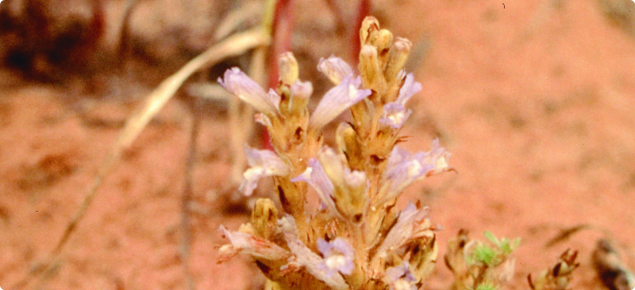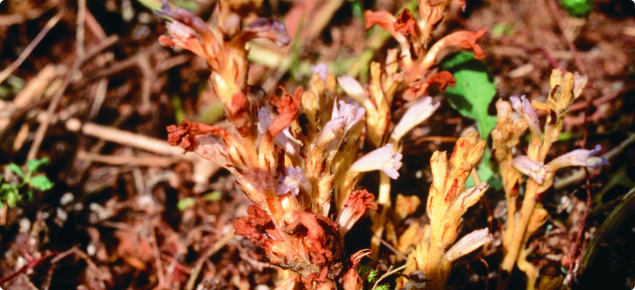Form: parasite — annual
Status: not present in WA
Appearance
A herbaceous annual root parasite without chlorophyll.
It produces large numbers of tiny seeds that are distributed widely as contaminants in seed or in soil on dirty machinery, clothing and footwear of workers. They are also well dispersed by wind and water and in mud stuck in animal's fur and feet. Seeds also survive passage through the intestinal tract of sheep, cattle and goats and can remain viable in the soil for many years.
Stem: a main stem emerges after a considerable period of growth underground. Stem is erect, small, thin, richly branched (in branched broomrape), brown or yellow straw coloured, glandular pubescent, 10-30 centimetres high — branched stems terminate in flowering spikes.
Leaves: reduced to purplish scales.
Flowers: An erect spike of flowers appears in spring and summer. Flowers resemble small snapdragons, ranging in color from white to blue or violet. Twenty or more flowers cluster to form a spike-shaped flower head. Upper flowers are stalkless and lower flowers have short stalks. Stems and flower heads are covered with very short glandular hairs.
Fruit: capsule, one celled with four chambers, many seeded; seed minute about 0.3 millimetres long, egg shaped, dull yellowish brown, nettled, veined.
Online weed identification training
Login or set up a new account on DPIRDs online training site to access:
- a training course on how to identify branched broomrape and report it.
- training material that you can use to teach community groups how to identify branched broomrape.
Agricultural and economic impact
Branched broomrape can parasitise a wide range of crops and pastures from several plant families pasture legumes, solanaceous vegetables, pulses, cucurbits and brassicas. Host plants include canola, cabbage, cauliflower, celery, hemp, lettuce, sunflower, linseed, spinach, chickpeas, beans, lentils, flax, burr medic, clovers, rockmelon, capsicums, eggplant, potatoes, tomatoes and onions.
Broomrapes can cause significant yield losses. For example, affected canola plants may not flower so there is no yield. Chickpea yields may be reduced by up to 50% with remaining seed being of poor quality. Some crops, such as cabbages and celery, may yield the same amount, but the plants will be yellow and unappealing to consumers.
The weed's presence could result in partial or total crop losses and the possible loss of potential to produce some crops in heavily affected areas. Broomrape can also cause loss of export markets interstate and overseas, and increases in management and control costs.
Branched broomrape will also parasitise a range of weeds, enabling it to reproduce even when crops are not present.
Declared pest category
The Western Australian Organism List (WAOL) contains information on the area(s) in which this pest is declared and the control and keeping categories to which it has been assigned in Western Australia (WA). Search for broomrape in WAOL using the scientific name Orobanche. Each Orobanche species in WAOL has a declaration and declaration map.
Requirements for land owners/occupiers and other persons
Requirements for land owners/occupiers and other persons if this pest is found can be sourced through the declared plant requirements link.
Search > detect > report
| MyPestGuide™ Reporter | Pest and Disease Information Service (PaDIS) |
Detectability: very hard to find. Branched broomrape plants are small, not very conspicuous and are only visible above ground for a short time. Look for thin or chlorotic (yellow) crop patches and pull up some plants: check the roots for the presence of immature broomrape plants. In spring, look for emerged broomrape in the headlands and around edges of crops. Broomrape could be found anywhere in a pasture or vegetable crop. Branched broomrape could be attached to weeds in crops or pastures. Branched broomrape is small, only about 15 centimetres in height, and does not have chlorophyll so even fresh plants are brown or straw-coloured. It does not have recognisable leaves - they are reduced to small purplish scales along the stem. The flowers are tubular and lilac-violet around 1.5 centimetres long, perhaps tinged with yellow. The seeds are tiny, like specks of dust, and can remain viable in the soil for some years.
Branched broomrape could easily be confused with common broomrape (Orobanche minor), but common broomrape is usually larger and more robust, with a single pinkish-brown stem, and tubular white flowers with brown or purple stripes.
Who should look for it: branched broomrape is not known to occur in WA; however, members of the grains industry, seed industry (particularly clover producers) and vegetable industry should be aware of this weed.
When to find it: branched broomrape can only survive by parasitising a suitable host plant and spends most of its life underground, emerging about 90 days after germination. It is most likely to be found in late spring to early summer.
Where to find it: branched broomrape will only be found attached to suitable host plants. It could potentially be found anywhere in the South West Land Division.
Report: this pest to the Pest and Disease Information Service using the contact details given below or by using the MyPestGuide Reporter app or online reporting tool.
Control method
Report the presence of this organism before undertaking a control measure. Control methods for this declared plant can be found through the broomrape control link.


